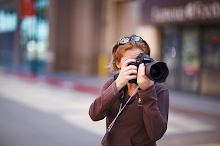Yesterday afternoon I attended a good Strobe Lighting 101 type of class through
Pictureline (must remember to check out their new store too). It was exactly what I needed, from talking about the different types of lights, the different systems (pocket wizards, etc), diffusers, etc.
There's a lot that can be learned out there -- and of course every photographer is going to have their own lighting set up that is that much different. Photography with lights is as much as stylistic statement as 'regular' photography itself.
In this case, Christopher (the instructor) uses two lights and no more. From what I gather, three is usually the standard, but I'm still ... gathering.
I really light the light from shooting through an umbrella and while soft boxes are nice, the light seems so .... fake. You just don't GET natural light that is like that. Not often at least (haze day, light through curtains, etc maybe....).
Mostly, I love that I can absorb this information, engage in excellent discussions and walk away that much wiser and with MUCH to think about.
Do I own any lights? no. I've been advised to figure out WHAT you want then get them all at once. Logical and sensible.
########
On the book front, I finished off the Best Business Practices book today -- finished the Close-Up photography book a few days ago. The Close-Up book has me artistically inspired again, which is just an awesome feeling. I also feel like I can pick it up and read a few pages to recapture that feeling whenever I need it. THAT has great value no matter the source. I try to not like the author because he's capitalized his books into online courses and other such, but the truth is that he is VERY damned good at what he does - which is teaching. I'm just more likely to pay for a professional redesign of my website before an online course when there's BOOKS on the same topic out there.
The Business book was excellent -- if I ever purge through books, that's one that I'll keep without a doubt. I'm staying on the business trend for now, as I don't want to fill my head with other photography inspiration quite yet. So it's the Guide to Building Your Photography Business. So far, looks like a quick read with huge margins and ugly photos. w.t.f. I'm sure I'll get something out of it, but it's cheaply printed and not a great first impression.
onward!















